pelmeni
I’m worried that by writing about pelmeni, the famed Russian meat-filled dumplings with a cult following, I might inadvertently open the Pelmeni Pandora’s box and pandemonium will ensue. This is a dish that elicits passionate responses as there are just as many different persuasions on how to make pelmeni and how to eat them as there are Russians, probably more. And while the gist might be the same, the nuances, the proportions – will vary vastly. Whether or not you put garlic in your filling can become a central argument point of the evening. And believe me, it’ll turn into a very long evening, indeed. As far as my personal experience goes, every Russian family I’ve ever met (and I’ve met many given my background) equipped with a recipe will lay claims to making not only the best pelmeni, but also the most authentic. Authenticity is huge with Russians. The number of times I’ve heard at a dinner table, “That’s not a real [],” – I’ve officially lost count. To prevent another heated debate, I’d like to tell you, right off the bat, that this is just my family’s version. And, as expected, I like my version the best. But that’s entirely a matter of opinion.
If given the opportunity, I could wax poetic about pelmeni – I’d like to write it little haikus about how delicious they are, how they make a night of no-time-cook-dinner into a veritable feast. But then I’d be writing poems and totally forget to give you the recipe. So you’d be looking at pictures of pelmeni and how to make them without actually know how to bring this bounty to your own table.
Pelmeni was the holy grail of my childhood favorite foods, of which there were few. You know how so many kids are picky about food – things they’ll eat, things they won’t touch. I was one of those kids – something that’s hard for me to understand now, given my career choice. My mother could probably count on one hand the foods I would always be enthusiastic about, and tried her best to keep them in her regular repertoire. And pelmeni sat firmly at the top of that list. I could have those for breakfast, lunch, or dinner – in fact, I think I did request them for breakfast a few times!
Given pelmeni’s importance in Russian cuisine, it’s only appropriate to provide at least a smidgen of history on this beloved fare. It’s one of the most popular Russian dishes around (there are restaurants in Russia specializing in nothing but various dumplings), but here’s where history gets a bit murky – and showcases that cooking, at its heart, is a global thing – connecting countries, continents, and cultures. Pelmeni, if we really get to the bottom of it, traces their roots all the way back to Asia. It’s very likely that pelmeni made their way to Russia by way of Mongols (who occupied Russia for hundreds of years), who had, in turn, borrowed the idea from the Chinese. A salt-preserved, meat-filled dumpling would keep for some time; was portable, and thus was an ideal, filling fuel for traveling armies, hunters, and whoever else found themselves on foot for some time and needing a portable meal. It’s no wonder pelmeni made a particular impression in Siberia, where long, cold winters allowed for these to be made in batches, then carried along on lengthy journeys to provide a quick, hearty, and filling meal.
I remember when I was little, my mother and I would set aside half a day to make dozens upon dozens of pelmeni in one sitting. We’d make a couple of hundred dumplings at a time, separate them into individual portions, and freeze until a weeknight when we needed a quick dinner. Back then, there was no prepackaged, prepared food in Russia, so your meals had to be thought of in advance. This was our equivalent of “fast food” – and it was delicious, albeit time-consuming. My mother’s meticulous method of shaping the dumpling (one of the two methods I’ll talk about below in the recipe) was to roll the dough out thin, cut out circles using a flipped-over glass, and hand-shape each dumpling, resulting in a tortellini-like appearance. No matter how hard I tried, my mother’s pelmeni always turned out better-looking than mine, though she’d denied it at the time. However, I’m no fool – years of pelmeni-making experience trumped my six-year old’s dough-shaping abilities.
And then, when we’d finish making them – dinnertime would come. I’d eat my pelmeni with eyes closed in reverie – the dumlings were a revelation with every bite. Our family dough was thin and delicate, like gossamer, and melt-in-your-mouth delicious. And the filling was always generously seasoned, hearty and juicy. I had versions of pelmeni at friends’ houses where the dough was thicker, dough-ier (if that’s a word) – but I always preferred the translucent thinness of my mother’s lighter hand.
With such sublime childhood memories, I wanted to recreate the recipe of my childhood, which meant going to the source – my mother – but, that was easier said than done. Getting the recipe out of my mother proved to be harder than I thought. After years and years of being in the kitchen, she, like many experienced home cooks, does it “by hand”. This means, that our short and frustrating conversation was peppered with expressions like “a little of this, and a little of that”, or my personal favorite, “until it looks ready”. After half an hour of fits and starts, she gave up and said, “Go over our family recipes – you have them with you. I can’t give you more information than I already have.”
I hung up started to pore over the scribbles and fragile vellum with typed up text. The documents were so delicate I was afraid to breathe on them. But reading over the recipe proved almost more frustrating than trying to get it our of my mother. “Add a little water,” read one line. Another line said, “1 kg of mixed meat”. How little is too little water? And what kind of meat – was it it a blend? Did you have to use an even mix of two meats? Three?? As far as ratios went, I was on my own – a daunting and thrilling task.
From various research and poking about the interwebs, I decided that a blend of two types of meat was in order. Pork seemed to be present in most recipes, buy my first attempt was mixing together beef and turkey. I was trying to avoid going the what I suspected to be a necessary pork route for my pork-shy boyfriend who grew up in a kosher home. I didn’t want to “push” it – I knew his unease with pork, and was hoping that I could find a pork-free alternative. But the beef-turkey filling wound up being too dry, the kind of dry where I knew that pork would fix the issue at hand. I decided to mix beef with pork to give the dumplings their much-needed moisture. I also was rather generous seasoning the meat. And while I was consulting various sources on all things pelmeni-related, I found, and used, Anya von Bremzen’s genius trick of adding crushed ice to the meat.
The second version of pelmeni, filled with their porky goodness, was a knockout – the dough – delicate; the filling – savory and boldly flavorful. We declared it a success, and my only regret was in making one hundred and not two hundred of these. Next time, I will double the batch, and use the pelmeni mold to speed things up (because it totally saves on time!). But when I want to remember my childhood cooking days with mom, I’ll put the pelmeni mold aside and shape the dumplings by hand, and relive my picky-palate, pelmeni-adoring days all over again – except this time, my dumplings will be much, much prettier.
Pelmeni
How to eat pelmeni – I am an ardent vinegar-and-sour-cream-in-my-pelmeni kinda gal. But even some of my closest friends have old me that I’m “doing it wrong” – adding only one or the other. I, however, firmly stand my ground – it’s vinegar AND sour cream for me. If you think that mixing sour cream and vinegar is blasphemy, let’s agree to disagree. Everyone is deeply committed to their way of pelmeni consumption and there won’t ever be consensus, though a few of my friends have now crossed over to my mixing ways. Also, you can add a dollop of butter on top of your cooked pelmeni in addition to sour cream and/or vinegar – if you want to go all out.
Lastly, on the subject of dough – in the past, my mother and I have have used wonton wrappers to make our pelmeni – it really does save you some time, although for a most celestial experience, making your dough is essential. Still, the wonton wrappers, in a pinch, do the trick with much gusto. And might be a good “intro” way of making your own pelmeni at home.
For the Dough:
3 cups unbleached all-purpose flour
1 teaspoon salt
1 large egg
3/4 cup very cold water, plus up to 1/4 more, if needed
For the Filling:
1/2 pound ground beef (you want to use fattier ground beef her, not leaner)
1/2 pound ground pork
2 medium-size onions, finely chopped (or pureed in the food processor, read on)
1/4 cup crushed ice, or very cold ice water
2 teaspoons kosher salt
Freshly ground pepper to taste
Bay leaves
Peppercorns (both for when you cook your pelmeni)
To Make Dough:
In the food processor, fitted with the metal blade, blend the flour and salt. With the motor running, add the egg, then, in a slow and steady stream, pour the water. Process until the dough forms into a ball and hangs around the blade. Transfer dough onto a floured surface and knead until smooth, soft, and pliable for 2-3 minutes. Cover with a clean kitchen towel (linen or cotton) and allow to stand for 30 minutes (this softens the glutens). While the dough is “hanging out”, prepare your filling.
To Make the Filling:
In a large bowl, combine all the filling ingredients. [If your fridge doesn’t make crushed ice (mine doesn’t), you can take your ice and pound it, lightly, in a ziploc bag, using a hammer, or a mallet.]
To Assemble Pelmeni:
Divide the dough into 4 equal parts. Keep 3 parts covered under a towel.
If Using Pelmeni Mold:
On a floured surface, using a floured rolling pin, roll the dough out to a little thicker than 1/10-inch thick. [You want this to be thicker than if you shape the pelmeni by hand (see below) – because the with the pelmeni mold, you will have to get the pelmeni out, plus you will place a rolling pin on top to roll, so your dough will need to be a little bit thicker and more durable.] The rolled-out dough should be slightly bigger than your pelmeni mold. Drape the dough over the mold and fill each opening (usually a hexagon) with a generous ½ teaspoon filling. Roll out the second piece of dough and drape it over the meat filling. Using a floured rolling pin, roll the pin until the pelmeni are formed. Take the pelmeni mold, flip it over a floured baking sheet and bang it a few times (like a tambourine!) to release the pelmeni from the mold. [I learned this trick with my last batch, and had to deal with some ugly pelmeni in the mix.] Flash-freeze pelmeni for 30 minutes, before placing them into a ziploc bag. Frozen pelmeni should store for up to 3 months.
If Shaping Pelmeni by Hand:
On a floured surface, using a floured rolling pin, roll the dough out to a little thicker than 1/16-inch thick (let’s say 1/13 or so). Basically, you want it thin, but not transluscent. Use a cookie cutter, or a glass, to cut out 2 ½-inch circles. When done cutting, lift the non-circle part, clump it together and place under a towel to reroll later.** {write about cooking a single pelmen here}
Place 1/2 teaspoon filling toward the bottom of one circle. Fold the other half over it, pick the circle up and, using your thumb and index finger, press the edges of the dough together until a semi-circle is formed. Take the two ends of the semi-circle, bring them together and connect. You have made your first “pelmen”. Continue with the remaining circles, and other pieces of dough, until you have run out of dough, or filling, whichever comes first. As you’re making the pelmeni, place them on a floured baking sheet. When the sheet gets full, place the entire baking sheet in the freezer for half an hour. Once the pelmeni are flash-frozen, you can transfer them into a ziploc bag where they will keep for up to 3 months.
When Ready to Cook:
Bring about 4 cups of generously salted water to a boil with a bay leaf and a few peppercorns flavoring your water. Drop 30-40 pelmeni in and cook 6-8 minutes, stirring with a spoon occasionally to prevent sticking. With a slotted spoon, carefully remove pelmeni from the water into 2 bowls. Add a teaspoon of vinegar to each bowl and a teaspoon of sour cream. Combine and eat immediately.
Makes about 100 pelmeni.
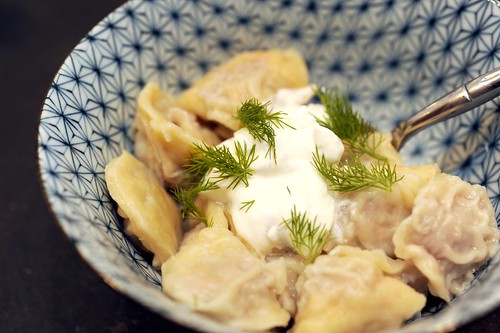
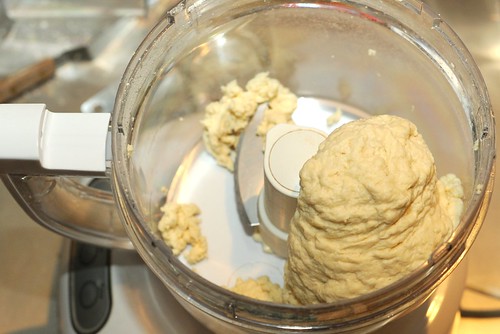
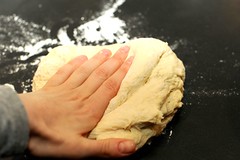

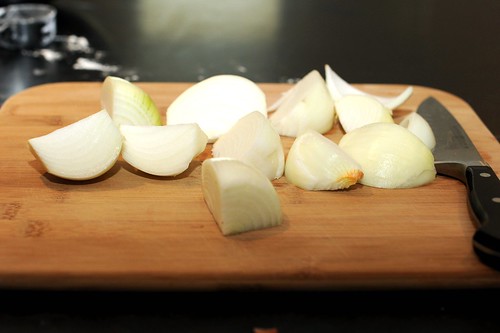

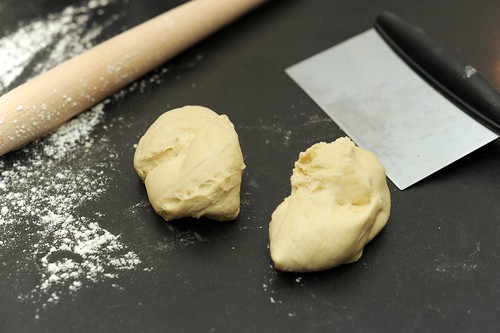

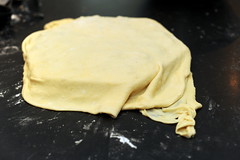

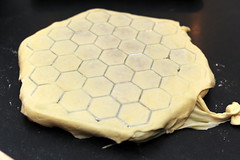
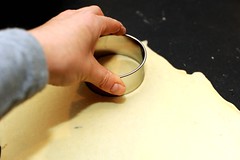
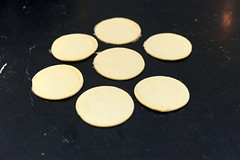
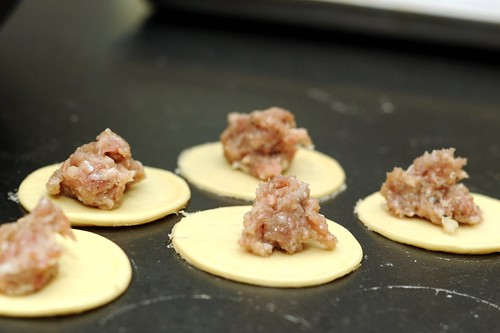
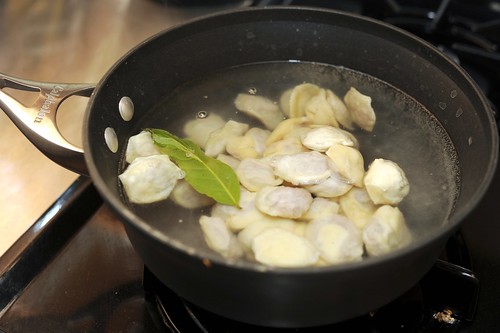
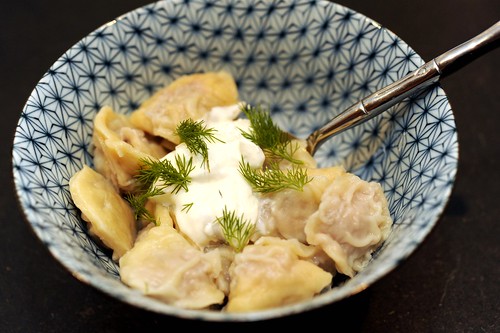
Fresh and Foodie
I’ve never heard of pelmeni, but I’m glad I stopped by for the read. These look delicious and beautiful, and I just love the mold you use to make them. Oh, and vinegar and sour cream sounds good to me.
Whitney
I’ve never had the pleasure of having a Pelmeni but man, I really want to try them now. I love the look of the mold!
Jess
Pelmeni! Pelmeni! I have been waiting for this. And with vinegar? YES.
Rachel
Oh, I’m so glad to see this. I first tasted pelmeni here in Canada, at a festival my city throws every year (held in a huge park, hundreds of culturally-specific booths offering food, shopping and entertainment). I didn’t really know where to look for a recipe, but I made my attempt last year with pyroghy dough (living on the Canadian prairies, Ukrainian food is a fond memory from my childhood, though I am not at all Ukrainian). I made the filling with ground pork, salt and onion, and it was very good. But I’m sure these will be so much better. I don’t eat much meat these days, but I will have no choice but to try these. Thank you!
Kasey
I.must.make.pelmeni.soon. Thanks for the beautiful reminder, Olga!
Sean
What an interesting dish! Sounds like a fantastic comfort food, and there really isn’t anything better than food taking you back to your childhood! Thanks so much for sharing this interesting story and recipe!
kickpleat
My mom and I would spend Saturday afternoons making Lithuanian dumplings for my dad – well not just for my dad, because we loved them too. My mom made them big, about the size of peirogies, but when I went to Lithuania a few years ago, I ate a ton of various dumplings and pretty much loved them all. So good. I’m going to try and get my dad to find those old recipes and send them my way! Hooray for going back to the past.
Elizabeth
I never thought there could be so much controversy over dumplings! These look very tasty. I love your memories of eating these in your childhood, foods that evoke such nostalgia are definitely my favorite.
Sara
I’m hardly an expert on pelmeni, but I have loved them whenever I’ve had them, on a trip to Russia and another one to Kiev. (The ones I had in kiev were jam filled with crushed honeycombs and dollops of sweet cream on top–goes without saying that they were memorable). I find it fascinating how each cuisine basically has a version of this: ravioli, pierogi, pelmeni, wontons…just must be something inherently satisfying about the combination of dough and a filling (and probably how it stretches a little bit of meat, etc., much further).
Radish
Sara – what you had were vareniki, most likely, not pelmeni. Vareniki made with meat are made with cooked meat, but sweet vareniki can come either filled with uncooked, or already cooked fruit such as jam. Regardless, they are absolutely delicious!
jordan
yep, looks just like what my mom and I make, inc the mold, which we had to bribe some old babushka for. Just didn’t seem right to ask someone to send or bring it us back from Russia–those suckers are heavy. Your recipe is basically identical to ours. So while we’re on the mold subject, might you happen to have a good recipe for “oreshki” cookies, ones also made with mold iron (shaped like walnuts) and stuffed with cooked condensed milk? Thank you! Love your website. We’re obviously fellow Russians.
Mairi @ Toast
What a lovely post, I have never heard of pelemi but after reading your post I would like a bowlful right now…and vinegary & creamy would work for me too.
Radish
Jordan – thank you! Oreshki is one of my future projects :) you were reading my mind!
Tyler
Where’d you get your pelmini mold from? My boyfriend and I really want to make these now, and I bet the mold could also be used for homemade ravioli, so it seems like a justifiable purchase!
Radish
Tyler – I borrowed mine from friends, but I know they’re sold on eBay too!
jordan
Thank you! I can’t wait for your “oreshki” recipe, especially now that I know how truly authentic your Russian recipes are. I am getting the mold for my birthday coming up in a few weeks…
Radish
Jordan – can you please post a link to the oreshki mold? I’d be delighted to get my hands on one.
Irina
OMG, my father is a HUGE pelmeni fan and I used to make these often for him a few years ago! And although making pelmeni is meditative, I will have to hand in my “Russian” card – I never liked eating pelmeni, even as a kid, to much of the family’s dismay. Actually, and it may be just happenstance, our “recipe” for pelmeni is almost exactly like yours, we just put a bit more stuff in the meat (like parsley, dill, etc). Nothing wrong with vinegar either :), actually both vinegar and sour cream and some salt used to make it more palatable for me when I was forced to eat pelmeni at family gatherings back home. The other preparation method for pelmeni is to steam-fry them, similar to gyodza. I remember my grandmother doing that. Thank you for a nostalgic post. :)
Gail
What is the difference between pelmeni and kreplach? I know kreplach are used as soup dumplings, but other than that, I’m not sure what the difference might be.
Great post Olga….LOVE the mold you found, too!!!
Jordan
Olga, this was the best I could for the oreshki mold. I believe most of the links on that page will forward you to e-bay.
http://www.sportslinkup.com/shop/0-Oreshki-mold-1-bin.html
I will also check out some Russian stores in the area today. We don’t necessarily have the most abundant community here, so I don’t let my hopes get too high. If I can’t find anything, I’ll go the ebay route, or will see how much it would cost to ship one from Russia, where my mom’s going next month (for the 1st time in quater of a century–should be interesting). I don’t feel right asking her to bring one here in her luggage. I think it weighs like 100 lbs.
Gen
I am delurking because pelmeni are one of my favorite foods ever, and you have utterly blown my mind with the concept that there is such a thing as a pelmeni mold. I have only ever made them the labor-intensive handmade way… this might just be the start of a grand new era of a freezer constantly stocked with pelmeni! My family recipe uses beef (perhaps because the family in question is Jewish–although I don’t keep kosher and will happily put butter on the cooked pelmeni); it adds a little pepper in the filling and no ice, but otherwise is very similar to yours. I may have to give your dough-making method a shot as well. As always this looks delicious!
Brian @ A Thought For Food
You make these look so easy! Given the meat filling, I may try to veggetize (yeah, i just made up that word) them and do more of a perogi filling… cheese and potato or a ricotta filled one.
But these look fantastic!
Radish
Brian – go for it, but it won’t be pelmeni. By definition, they have to have meat in them :-) I can’t wait to see what you come up with though – as I’m sure it’ll be really tasty!
Ana
Brian — as a Russian vegetarian (tragic contradiction of terms), I can tell you that there definitely are ways to “fake” the meat, as long as you get the texture and spices right. Pelmeni meat needs to be juicy, but also to stick together; I would say that in my family, prevalent spices include black pepper and dill. With regards to texture, you could try using a vegetarian ground beef imitation (MorningStar is alright, Quorn is my favorite, Trader Joe’s has some decent stuff) and adding egg, if you are not vegan, to make it stick. To enhance the amount of juice, mixing with very finely diced onions and maybe breadcrumbs (which would absorb the broth in which you boil the pelmeni, and expand) could do the trick.
I know it’s hard, and technically not authentic… But now that we are moving forward as a planet, I think even cuisines as hearty as Russia’s can be made to accommodate!
Ana
Olga — you should provide some ideas for “lucky” pelmeni recipes, too! In my family we always had one or two filled with either just dough, or hren, or far too much black pepper to make someone at the table wince hilariously from the surprise, but then get told that they have good luck for a week or something along those lines. I’ve heard of other families using sauerkraut and other random items for the “lucky” filling.
Radish
Ana – never heard of the “lucky” pelmeni – sounds hysterical though.
Nathalie
Wow, thank-you for sharing your family recipe with us! These things never get written down, and then they’re lost, so I’m glad you worked it out.
That honeycomb shaped thing is awesome! What a quick way to shape dumplings, probably of any kind.
Vicki
Please, please couldn’t you answer the question about pelmeni and kreplach? I want to know, too.
snippets of thyme
I love learning about new foods. Never heard of these adorable little pelmeni. We are huge fans of dumplings of any kind. Thank you for showing how to make them.
Julia
Great post–and thanks for the clear, step-by-step pelmeni instructions. I will be making this!
Radish
Vicki and Gail – from what I understand (and I didn’t dig too deep due to time constraints this weekend) but kreplach and pelmeni are similar, except pelmeni is most often filled with a pork and other meat mixture, and kreplach is kosher. Also, kreplach dough often has oil in it. From my “taste” experience, however, pelmeni tastes more flavorful. Now that could be because there’s sour cream and vinegar on mine, but maybe it’s something else. Oddly enough, I didn’t grow up with kreplach (something that makes me very sad).
Olga @ Parting with sugar
Thanks for posting this recipe! I also had to endure receiving recipes from my grandmother where things were measured by consistency, eyeballing and experience. I didn’t even know moulds existed for making pelmeni, I definitely feel more excited about the idea of making them if I don’t have to do all of them by hand.
Will you be posting any recipes for syrniki?
Radish
Olga – what an excellent idea to do syrniki! Now I have a new thing to write about – brilliant!!
Jordan
Hey, Olga/Olga and all the other Russians flushed out by this post, have you guys seen this website: gotovim-doma.ru? An old friend of mine from Russia turned me on to it. They list some OLD long-forgotten recipes on it in all their canned-fruit-mayonnaise-soaked glory! I just like browsing through it for nostalgic value (for for chuckles). This said, I would LOVE to see a recipe for syrnishki on this blog! Also, Happy Woman’s Day tomorrow! Too bad it’s not a National Holiday here, don’t you think?
Radish
Jordan / Olga – I don’t know… I’m really meh about the Woman’s Day :) There are too many holidays as it is for my taste. Plus, since my boyfriend is an American it’ll be tricky to explain what the holiday is. But happy women’s day, indeed.
Jen
I always wanted to know how to tell my pelmeni and vareniki apart ! My great-grandma was from Russia and my grandpa talks about how she used to make kreplach. I wonder if that’s just the Jewish word for meat dumplings? That mold is too cool btw.
Olga @ Parting with sugar
Jordan – thanks for that website! I was really excited to see a recipe for pickled cabbage – yum yum. I just have to brush up on my Russian reading to get through some of these recipes.
Olga – my husband is Canadian and Woman’s Day is also a foreign concept to him. I wish it was more known in North America but I figure that Valentine’s Day fulfills the same role :)
Dana
What an awesome mold!!! You could use it for so many other things, most dumplings really. Your family’s version looks great, I agree that a thin thin thin dough is the key.
Kristine
As reading through the comments, I came opuon one made by Jordan about ”oreshki”. Oh my god- I used to adore those tasty little treats that would be made once or twice a year only. To think that I have actually forgotten about them. So, now I am set on getting myself a pan, and, while searching came up with this one and thought some of you might be interested. Here is the link http://cgi.ebay.com/Oreshnitsa-24-110V-/160555314601?pt=Small_Kitchen_Appliances_US&hash=item2561d7ada9 and its actually like one of those electrical sandwich makers. It certianly looksl ike an intersting option.
K
Looks delicious! Just a quick, nit-picky note — “wanton” is an unflattering adjective, e.g. “wanton cruelty” or “a wanton woman.” What you’re talking about are “wonton” wrappers — though perhaps they can be wanton in their deliciousness!
Kel
I made a batch yesterday using gyoza wrappers (I’m lazy) and a mixture of ground turkey and ground pork– they came out great! The moisture level was good, though the flavor was definitely different from how I remember pelemini being in Russia. But then again, we made them with a cabbage and meat mixture, so they were different from the start. Thanks for the recipe, it brought back memories :)
Radish
K – thank you for the edit – total typo, oops! I corrected it just now.
MCKake
OMG! My Lithuanian roomates in college would go home for the weekend and bring back hundreds of these for the dorm girls. Their grandma made them as treats and we devoured them in one night. I had never tasted anything so delicious on my life! I am off to get the ingredients for a weekend project.
THANK YOU!! Your picture looks exactly like the ones we ate so I know they will taste as good.
pelmeni :) « somanywordsorless
[…] I am reveling in the thought of these yummy little dumplings: pelmeni « Sassy Radish. […]
Ear Breads, Get in my Face (AKA, Consider the Pel’meni). — Mouth of the Border
[…] Update: My friend Olga just posted her family’s recipe for pel’meni and it looks like the dictionary entry for comfort food: Pelmeni, by Sassy Radish […]
Marcella Hazan’s “Turta” (Spinach and Rice Torta) | Three Clever Sisters
[…] packets of dough bursting with any variety of fillings. Travel eastward, they become pierogi or pelmeni. Further on, along the silk road one encounters tiny Turkish manti, and onward to China, they […]
panu
oh this sounds SO SIMILAR to the Momo that Tibetans and Nepalis adore, and even the Gyoza. However, Momos are definitely more similar, as they use the same filling, which is minced meat, onions, salt and ice if needed. I am very interested in seeing this.
Girls' Guide to Guns and Butter
I love pelmeni – I took just made a batch another day, but with venison only – still were fabulous. I also used the crushed ice trick, I also add it to kotleti, makes a big difference. My American husband loves dumplings and we all thought that these deer ones were particularly good (I don’t eat pork, so that was not an option, but otherwise I used beef some other times).
Gloria
Thank you for posting this! I’m on a dumpling kick, I made 200 Korean dumplings yesterday, our freezer will be bursting! My boyfriend is Russian, this is my second attempt making it and I’ll be using your recipe this time. The last batch was a bit too doughy for us. Anyway, I’m curious about the crushed ice, what purpose does it serve?
Radish
Gloria, it just provides moisture/juiciness to the meat without melting all over and making a watery mess.
Gloria
Thanks, Olga. I wanted to double check on the amount of salt in the filling. I put the two tablespoons of salt in the meat and thought it way too much so I poured out the access. They came out to be just short of being way too salty (still delicious). Is the two tablespoons of salt correct?
Tanya
Gloria, am with you on the salt. Added 1.5 tblsp and made about 100 of these. I am very sad at how salty they came out… But definitely agree – were otherwise very delicious :-)
Radish
tanya – so sorry yours were salty. i guess we like our pelmeni aggressively seasoned. :( i suppose it is a matter of taste.
lucy
this recipe is awesome, but i have to agree w/tanya about the salt… i added only 1.5 tbs of salt and they came out really salty. i used kosher salt — maybe that was the problem? as an aside, i used a pasta roller attachment to my stand mixer to roll out the dough, and it came out great!
Radish
Lucy and everyone – I’ll have to retest, thank you for your notes. In case it helps, I use Diamond Crystal kosher salt. Not table salt, not Morton’s kosher salt. I’ll retest however, and post updated stuff soon hopefully. Thank you all again!
Eric Bondarenko
All sounds good but have you tried adding lite sour cream to the dough?
Radish
Eric – I haven’t. what does that do to the dough? Sounds curious. Also, why lite and not regular sour cream?
Reg A. Klubeck
You show a picture of a honeycomb-like mold or form for shaping them, but don’t mention it in the text. Where does one FIND something like that?
“….porky goodness….” =.9
Radish
Reg – if you look for pelmeni mold on eBay, you will find it. Otherwise Brighton Beach Russian stores :)
Irina
I just made these! I am feeling so proud of myself *patting self on back*…hopefully they will taste as good as they look, LOL. Best part is making my Mamachka proud :) Thanks for the recipe!!!
irina
Radish
Irina – so glad. Let me know how the taste. And yes, your mom should be, and will be proud!
Irina
Thanks! Some questions:
If they are frozen, does the cooking time remain the same? (6-8 mins?) Also, if I have no bay leaf handy, what else can I use?
Spacebah!
Radish
Irina – Bayleaf is my absolutely favorite flavor for this, but a sprig of thyme should work. I find that the cooking time is not affected. Maybe by a minute, but not really. Pozhauysta.
Scott
Love Pelmini the mother of an ex GF of mine used to make them all the time. I haven’t had them in years, gonna make up a batch real soon. We used to eat them with a mixture of Kikkoman soy sauce, Maggi sauce, vinegar and a couple of drops of sesame oil. Salivating just thinking of it, cant wait to whip up a batch.
Ella
Have you ever tried using something other than crushed ice in the recipe? It seems like a waste of a flavor opportunity. I was thinking about freezing beef or chicken stock ice cubes or with maybe a little gelatin mixed in to make it sort of a Chinese soup dumpling, although I’m pretty sure I’m going to get shunned by a lot of Russians for even thinking this haha. I used a slider recipe before that replaced the steaming water with onion juice and since then I’ve always been on the look out on ways to replace water in recipes.
olga
Ella – I find that the aggressively seasoned meat is plenty flavor-wise. You can definitely try to make it into a soup dumpling, but it won’t be pelmeni. :)
ExileOnDaytonStreet
I’ll have to echo the comments about the saltiness of the meat filling here. This was my first foray into making my own pelmeni (I’ve had it storebought and from restaurants before), and I had two disasters. The first was my fault (used the wrong kind of flour, and it the dough was much too sticky), and the second was the 2 tbsp of salt. I looked at other recipes I was considering and they all had about 1/2 to 1 tsp (note teaspoon, not tablespoon) of salt per pound of meat, and I’m wondering if we got TEAspoons and TABLEspoons mixed up in the recipe here.
olga
ExileOnDaytonStreet – Hi there, so this is the seventh time I am changing the measurements to teaspoons. It looks fine on my end, but could you check to make sure it checks out? For some reason, the post reverts to tablespoons (thank you for pointing it out!) time and time again.
Suzanne
A dear friend of mine, who was a first gen Russian born in Harbin, Manchuria used to make traditional pelmeni then add it to chicken broth with a splash of soy sauce and white vinegar, a dollop of sour cream and dill sprinkled on top. It is an amazing mix of cultures, and a fabulous pick-me-up. Also, Ive made a variation of pelmeni with ground turkey mixed with a little olive oil for the meat which was flavorful and light.
olga
Suzanne – yes, that soy sauce part makes sense if she is from Manchuria — and what an amazing mix of cultures, indeed. Love that!
D.M. Grivjack
Thanks so much for this great post on Pelmini. I’m of Russian/Ukrainian/Polish decent on my father’s side but it took a cousin from my mother’s family who was a missionary to Ukraine to get me out to that part of the world and really try the cuisine. Let’s just say I had a similar experience to you but as an adult with Pelmini. Eating it for breakfast, lunch and dinner. I love it and push it on my friends all the time.
Recently I got myself entangled in designing a menu for a brewery/restaurant here in Philadelphia called “Crime and Punishment.” The idea is to have a small menu of tasty but simple Eastern European fare served as bar food, and I am currently starting my epic journey into making delicious but do-able Pelmini for the restaurant, and this post has been a great help.
I personally have stuck with the basic butter/sourcream and salt and pepper on mine. Do people usually dip Pelmini in vinegar? Or do you toss it? What kind of vinegar? Also, are there any other dipping sauces that people like to make?
I would also love any references that you found in your Pelmini research or favorite Russian cookbooks, and lastly a few people who have spent more time than I have in St. Petersburg have mentioned a delicious barsnack called “Fried Brown?” It’s just sliced deep fried rye bread with melted cheese and a dipping sauce. Have you seen any recipes for the sauce or do you have an idea what kind of cheese is usually used?
Once again thank you for the informative post.
Dan
olga
Dan – it’s regular distilled vinegar and you add a little to taste. Good luck wiht your venture – it sounds fantastic! We’ll have to check it out next time we’re in Philly. I’ll think of references to pelmeni… I think they are versions of dumplings Russians inherited from Mongolians who inherited it from the Chinese.. My mom used to make something with fried bread. Let me ask her – and i’ll follow up with you here! Oh, lastly, I think per earlier commenter, the Manchurian pelmeni are served with soy sauce.
suzanne
Oops… If the last post was referring to my comments, I should have been clearer in my description of the dish from my Russo-Manchurian friend. The version I described is served as a clear broth soup, with the soy, vinegar, sour cream and dill added at the table. Otherwise, she was a staunch traditionalist with her pelmeni with vinegar, sour cream and dill added just before service . Soy was added only with the broth version. Either way, pelmeni are so wonderfully addictive.
elicitwords.com Blog » Blog Archive » Cleanse Cleanse Cleanse
[…] Pelmeni Russian Dumplings […]
Olia
What a great post! I’m contemplating making vegetarian pelmeni this afternoon using imitation ground sausage from the health food store. Previously I’ve used wonton wrappers but found it to be too far from the real thing. This will be my first time making the dough. And I’m with you, vinegar and sour cream (with black pepper) is the only way to go. If I’m feeling really frivolous with calories, I’ll also start with a pat of butter. Mmm.
Bob Castro
My wife Tania is Russian from China we use sour cream,vinegar and soy.
Ken
I love the recipe, but I am curious as to what kind of vinegar you are using. Red, white, balsamic, malt, apple, or rice?
I love making and eating Pelmeni. I eat them with sour cream, sriracha and hot madras curry powder. I will definitely try vinegar next time
Douglas
I have not had pelimeni for 30 yrs. In winnipeg canada was my first exposure to this fantastic dish. Now i am vacationing in thailand where i was able to find a russian restaurant that has them. I was a little suprised when i asked for vinegar and they looked dumbfounded. Vinegar and sour cream definitely the way to eat them. Thankyou for your article . When i get back to canada i may try to make a couple hundred mysef.